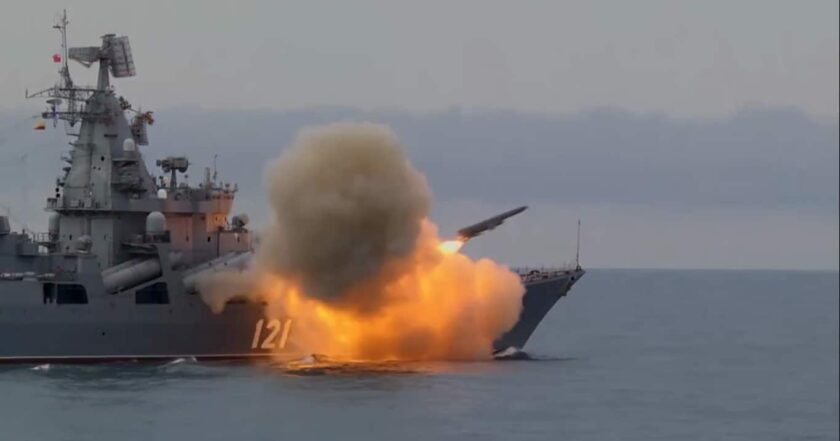Moskva cruiser: unknown details reveal how Ukraine located and sank russian flagship

On April 13, 2022, the Ukrainian defenders managed to find and reach the russian fleet flagship, the Moskva cruiser, with a Neptune missile. This was facilitated by lousy weather and the self-confidence of the russian sailors, Ukrainian Pravda reports.
The publication says that on April 13, the russian missile cruiser Moskva stood in the Black Sea approximately 120 km from the coast.
When the russian federation invaded the territory of Ukraine, the Ukrainian Armed Forces did not have over-the-horizon radars, and an ordinary radar cannot show targets at such a distance.
The article emphasizes that the invaders knew about it, so they felt safe.
However, around 4:00 p.m. on April 13, the operator of the Neptune complex received very unexpected data. Conventional radar showed a large target about 120 km offshore.
At that time, it was possible to assume that an object of this size in this sector of the Black Sea could only be the cruiser Moskva.
The publication reports that the Ukrainian missile men said nature helped them see the enemy target.
Because there were dense clouds over the sea then, this contributed to the radar signal being reflected from them to the surface of the water and back to the clouds. In such a corridor, the radar unexpectedly reached the cruiser.
The russians were so sure of their inaccessibility to the Ukrainian forces that, according to the Ukrainian Pravda (UP) sources, they probably did not even activate the air defense systems.
Although even activated air defense almost does not see the Ukrainian cruise missile because it flies over the water.
Western media published their versions of the defeat of the "Moscow."
Some wrote that NATO's European center allegedly confirmed the coordinates of Ukraine's target. Others said the American P-8 Poseidon reconnaissance aircraft was used to fulfill Ukraine's request, which provided the exact coordinates.
But the UP sources in military circles informed the journalists that the Ukrainians themselves could solve the tasks of incredible complexity and that the russian 120-meter mountain of iron was constantly seen and recorded with the help of satellites. The problem was not to find "Moscow" but to get it.
On April 13, a russian cruiser unexpectedly entered the damage zone of Ukrainian missiles. And as soon as it was recorded, two Neptune missiles were released.
Ukrainian Pravda also obtained a photo of this historic rocket launch.

Photo: UP
According to UP sources, the most exciting phase of the operation began just after the rockets flew into the sea. Neptune missiles had to cover the distance to the target in about 6 minutes.
But no one knew whether they had hit the cruiser because the Bayraktar drone operators refused to take off to verify the strike: they wouldn't have seen anything above the clouds and under the clouds, and they would have been shot down 100 percent.
The military understood that "Neptunes" hit the target when the Moskva cruiser suddenly moved and tried to hide behind the Boiko's rigs [oil platforms owned by Ukraine's former energy minister and pro-russian politician Yurii Boiko; Ukraine started criminal proceedings regarding the possible violation of Ukraine's laws and the embezzlement of state funds by Boiko while purchasing these oil rigs].
Also, four ships rushed simultaneously to the russian fleet's flagship of the russian fleet from different directions. Just then, an unexpected storm began at sea, and rescue operations became very difficult.
When the Ukrainian military realized that a tug had left Crimea for "Moscow," they realized that the situation on the cruiser was critical.
As Rubryka previously reported, the first combat use of the Ukrainian coastal mobile complex with Neptune anti-ship missiles was in the early days of the war. Then the Ukrainian rockets failed to hit the targets, but they saved Mykolaiv from the russian landing.
Reference
The first full-fledged Neptune complex on a new Tatra chassis was assembled in August 2021 before the parade for the 30th anniversary of Independence Day.
According to the UP, the first missiles ordered by the state for the army left for Odesa only on February 20, 2022.
On the night of April 14, two Ukrainian Neptune missiles hit the flagship of russia's Black Sea fleet with the most potent weapons. The cruiser "overturned and began to sink," Vladyslav Nazarov, an officer of the South operational command of the Armed Forces of Ukraine, reported at the time.
Cruiser "Moskva" became russia's most expensive military loss in the war with Ukraine.



















































